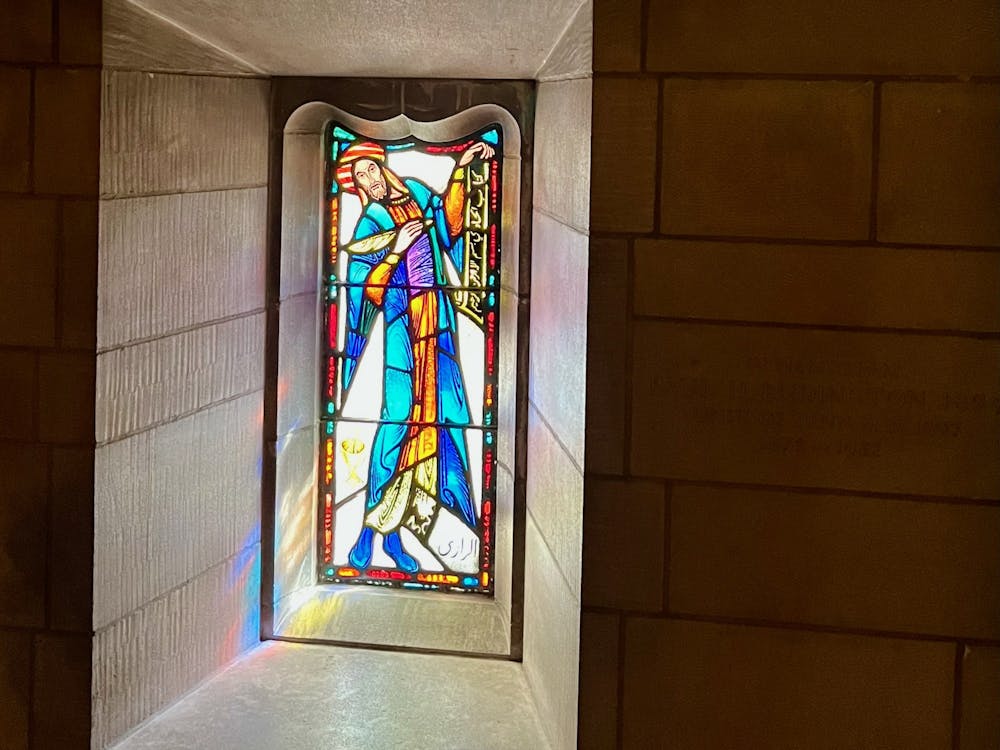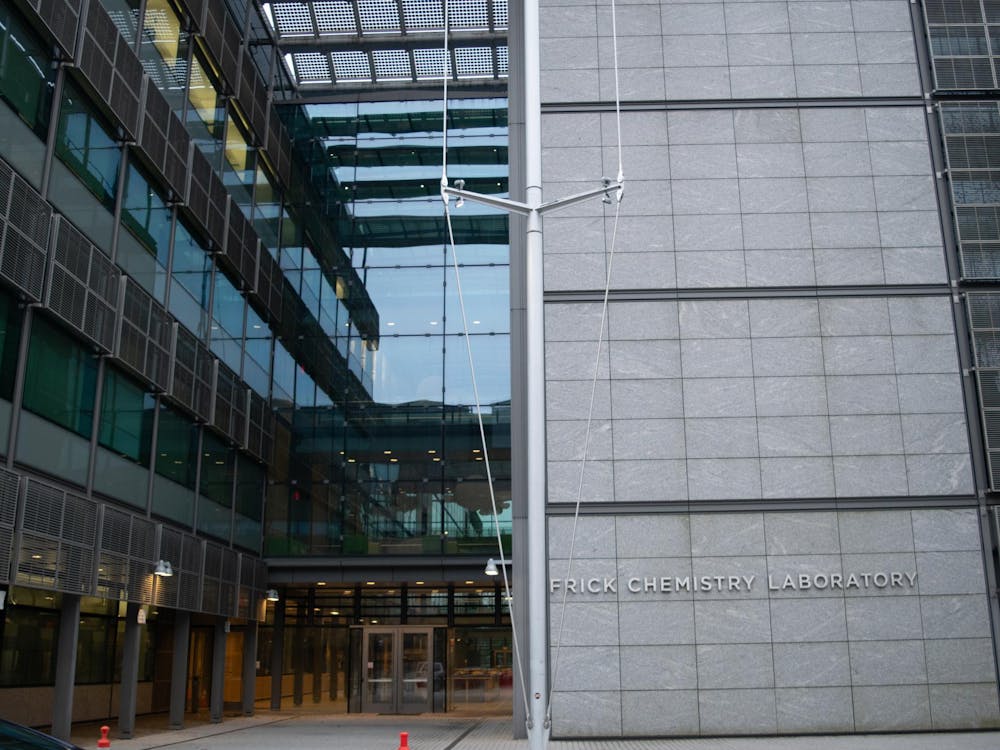In an experience I think is common for many Princeton students, I often find myself searching for more immediate significance to my studies: it is one thing to spend a lot of time reading and thinking about postcolonialism, but an entirely more difficult thing to find out how to work with an abstract name for a very real phenomenon in the contemporary world.
So, when doing some reading in a collection edited by Mahmoud Eid and Karim H. Karim titled “Re-imagining the Other: Culture, Media, and Western-Muslim Intersections,” I was shocked and excited when I encountered a reference to the very campus where I was reading. Finally, here was the immediate significance I was looking for: a one sentence mention of a single window in the Princeton University Chapel.
Chapels are, by conventional definition, places of Christian worship and Princeton’s chapel is no exception; the most common events at the Chapel remain Christian services. According to its official website, the building was constructed to “permit the University to maintain its religious heritage” as an institution closely linked to the Presbyterian church. The visual elements of the Chapel represent this Christian identity, such as the building’s Collegiate Gothic style, a reference to Gothic cathedrals in England, or its stained glass windows filled with New Testament iconography. Moving through the Chapel, one is confronted with image after image of Jesus Christ, quotes from the Gospels, and references to Christian epics like the “Divine Comedy” and “Paradise Lost.”
And yet, if an adventurous visitor to the Chapel immediately turned right upon entering they would be confronted with the seemingly odd sight identified by Eid and Karim: a stained glass window depicting the Muslim Abu Bakr al-Razi, a ninth-century Persian doctor, philosopher, and scientist, accompanied by Arabic script which reads “In the name of Allah, the merciful, the compassionate.” For an explicitly Christian building constructed in the 1920s, the only depiction of the Islamic tradition in the Chapel being one of the first images one encounters is certainly confusing and even contradictory. How can we wrap our heads around this singular place for Islam in the overwhelmingly Christian imagery of the Chapel?
To begin to unravel this mystery, one has to understand that the definition of Christian imagery in the Chapel is quite expansive. Despite the overwhelming presence of Christian imagery, there was also an intentional effort on the part of Ralph Adams Cram, the Chapel’s architect, to embrace a sort of semi-secular Gothic style. As the Chapel’s official tour tells it, Cram believed “Classical architecture must not be used as the visible expression of Christian religion.” Cram believed any endorsement of Christianity must come from the narrative told by the Chapel, making the design a sort of rhetorical defense of the virtue of belief in God.
In the case of the Chapel’s stained glass windows, they are not meant to be explicitly Christian and instead embrace a progress narrative of “Western civilization” as “rational” evidence for the importance of Christianity. Thus, characters from the Gospel appear alongside a variety of less explicitly or not-at-all Christian figures: Jesus and his apostles exist alongside Plato, Immanuel Kant, James Madison, Emily Dickinson, T.S. Elliot, Baruch Spinoza, and, of course, al-Razi.
Alongside windows focused on Biblical stories like the “Book of Job” or Jesus’s crucifixion, there are windows centered around poetry, law, philosophy, and science. To quote the Chapel tour again, the purpose of this inclusion of non-Christian sources was to actually highlight the power of Christianity; as Cram says, “we’re confident enough in our claims that we’ll see any truth that you do have is welcome inside.” According to the stained glass narrative, all thinkers, even those who claim to be secular or belong to totally different religious traditions, contribute to the greatest evidence of the glory and power of the Christian God: the forward march of the West.
Within this framework, the inclusion of al-Razi in the Chapel’s narrative makes perfect sense. While al-Razi was in no way Christian, al-Razi played a key role in the history of a number of fields which are foundational to the civilization half of the phrase “Christian civilization.” Al-Razi’s list of accomplishments in “secular” fields are incredibly expansive, contributing to the development of medicine, chemistry, and philosophy all while he directed an important hospital in Baghdad in the midst of the Islamic Golden Age. Considered one of the most important individuals in the history of medicine, an article in the Annals of Saudi Medicine attributes to al-Razi such achievements as pioneering neuroanatomy, founding the first recorded psychiatric aftercare facility, publishing the first monograph about pediatric medicine, and being the first to differentiate between smallpox and measles. In chemistry, his work in alchemy led to his being credited with the discovery of ethanol and sulfuric acid.

Crucially, these achievements were in no way restricted to the context of “Islamic civilization,” as al-Razi became an important thinker across Europe and the Middle East, frequently known by the Latinized name Rhazes. As the Journal of the British Islamic Medical Association notes, al-Razi made key contributions to the Greco-Arab medical tradition which serves as the foundation for the practice of medicine in a wide range of geographic and cultural contexts. Most of al-Razi’s works were translated into Latin and other European languages, serving as vital parts of the curriculum in early European medical schools. As al-Razi’s solitary window in the Chapel attests to, if one wants to tell the story of science and medicine within Western, Christian civilization that story actually cannot be told without the work of Muslim thinkers and practitioners.
Standing in front of al-Razi’s image myself, I was struck by how a small window, tiny in comparison to the windows in the main body of the Chapel, could have taken on such a significance for me: why was it even notable that a small portion of the Chapel made reference to Islam? The answer, I think, lies not so much in the material reality of the Chapel but instead in the narratives of the society around it. Having been born in the post-Sept. 11, 2001 world, I have never existed in a context where the opposition between West and East, erroneously equated to Christianity and Islam, was not at a fever-pitch.
Attending Princeton has only made me more acutely aware of this fact: reading the critique of the University’s Department of Near Eastern Studies for helping to popularize the “Clash of Civilization” narrative by Edward Said ’57 in a course in that same department induced a healthy amount of cognitive dissonance in me. And yet, as a material sign of opposition to these narratives, there was a stained glass depiction of al-Razi, the doctor who had an incredible impact on science in both “West” and “East” by drawing on multiple traditions and histories of medicine.
In the face of my lived experience as a student at a university still embroiled in controversies over diversity and its over-emphasis on the Western Canon, here was a tangible symbol that the foundational dividing line that designates part of the world as the “West” cannot be easily drawn. The West’s “others” have made such decisive contributions to its history that they must be acknowledged through featuring Islam in a Christian building.

For me, al-Razi felt so important as an embodiment of my academic musings during my first two years at the University: here were the stakes of all those abstract terms like Self-Other Dichotomy, Postcolonialism, and The Canon made material in glass. To quote Said in “Orientalism,” where the aforementioned critique of Princeton can be found: “We must take seriously Vico’s great observation that men make their own history, that what they can know is what they have made, and extend it to geography: as both geographical and cultural entities—to say nothing of historical entities — such locales, regions, geographical sectors as ‘Orient’ and ‘Occident’ are man-made.”
Similarly, we must take seriously a small stained glass window in the Princeton University Chapel: the figure of al-Razi reminds us that there is no easy narrative of European, Christian, or Western history which can be meaningfully separated from the “West’s” “Others.” Distinctions that are so easily bought into over the course of our careers as Princeton students are just as man-made as glass: maybe we can try and find if they are just as easily breakable as well.
David Chmielewski is a junior at Princeton University concentrating in English.
Self essays at The Prospect give our writers and guest contributors the opportunity to share their perspectives. This essay reflects the views and lived experiences of the author. If you would like to submit a Self essay, contact us at prospect@dailyprincetonian.com.








